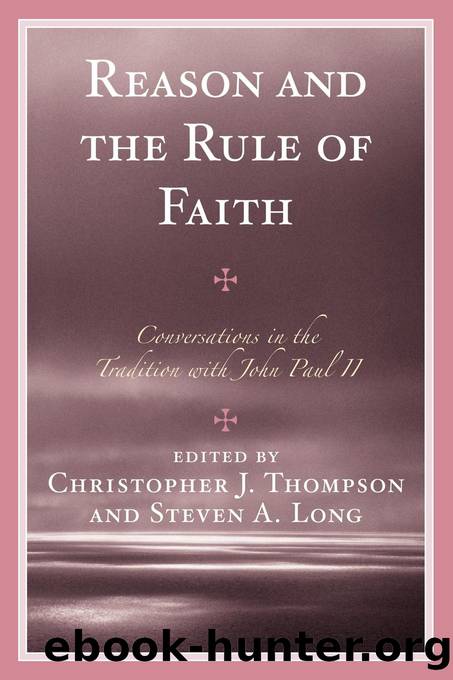Reason and the Rule of Faith by Thompson Christopher J.;Long Steven A.; & Steven A. Long

Author:Thompson, Christopher J.;Long, Steven A.; & Steven A. Long
Language: eng
Format: epub
Publisher: UPA
Published: 2011-08-15T00:00:00+00:00
CHAPTER NINE
FIDES ET RATIO AND THE ENGLISH CATHOLIC REVIVAL: CLASSIC APOLOGISTS ON FAITH AND REASON
David Paul Deavel
INTRODUCTION: THE INSPIRATION OF CONTEMPORARY AMERICAN APOLOGETICS
âTheological work in the church,â Pope John Paul II tells us, âis first of all at the service of the proclamation of the faith in catechesisâ (FR, §99). Apologetics and evangelization are two activities incorporating catechesis. The early-and mid-twentieth-century was not only a startling, flowering period of theology in the Catholic Church. England, despite producing little high-level Catholic theology (Anscar Vonierâs A Key to the Doctrine of the Eucharist being a prominent counter-example) primarily experienced a flowering of popular apologetics at a high level, with figures like Robert Hugh Benson, Ronald Knox, and Frank Sheed and Maisie Ward gaining popular audiences for Catholic topics with their witty yet wise presentations of Catholic faith, as well as with their success in other genres. Knox wrote mysteries and Benson wrote popular novels. Sheed was the only ânon-literaryâ character of the group, yet his wife Maisie Wardâs biographies of people like Newman and Chesterton, as well as the publishing company he and she owned together, provided the two with a certain amount of comparable public exposure. (It did not hurt, either, that Benson was the convert son of an archbishop of Canterbury and Knoxâs father was the Anglican bishop of Manchester).
Despite the literary and popular quality of this movement, Cardinal Dulles characterized the mood of this apologetic movement as âat once rationalist and authoritarianâ (A History of Apologetics [Philadelphia: Westminster, 1971], 219), contrasting their writings negatively with those of continental apologists like Louis Bouyer and Heinrich Schlier. Yet the Anglo-American movement of Catholic apologetics that revived after the Second Vatican Council still finds its most popular models in the former group. While two of Louis Bouyerâs apologetics books have been reprinted recently,1 Schlier is almost unknown in America and England. Robert Hugh Benson, though not prominent, is gaining popularity again.2 Catholic Answers, the largest Catholic apologetics organization in North America, looks to Knox and Sheed especially for their examples, and their catalogue includes numerous books by both men, as well as the Catholic Evidence Guild Training Outlines compiled and introduced by Sheed and Ward. Karl Keating, the founder of Catholic Answers, has written the introduction to Ignatius Pressâs 2000 edition of The Beliefs of Catholics and refers to Sheed and Knox constantly on âCatholic Answers Live,â the organizationâs daily call-in radio show.3
In short, the North American apologetics scene shows much more influence by the English Catholic revival authors than by the continental writers. These writers, claims Cardinal Dulles, shared a ârationalist and authoritarianâ streak, that is, perhaps an imbalance in their understanding or presentation of the relationship between faith and reason. Being somewhat authoritarian, it is obvious that these writers, mostly converts, took their lead from authoritative teachings of the Church, most obviously from Vatican Iâs declaration Dei Filius. I want to examine more closely my selected apologistsâ treatments, both explicit and implicit, of the relationship between faith and reason. I
Download
This site does not store any files on its server. We only index and link to content provided by other sites. Please contact the content providers to delete copyright contents if any and email us, we'll remove relevant links or contents immediately.
Getting It, Then Getting Along by L. Reynolds Andiric(629)
Religion and Politics Beyond the Culture Wars : New Directions in a Divided America by Darren Dochuk(446)
Global Justice, Christology and Christian Ethics by Lisa Sowle Cahill(409)
Positive Psychology in Christian Perspective: Foundations, Concepts, and Applications by Charles Hackney(341)
Forgiveness and Christian Ethics by Unknown(327)
Douglas Hamp The First Six Days by Unknown(256)
The Horrors and Absurdities of Religion by Arthur Schopenhauer(241)
Insurgency, Counter-insurgency and Policing in Centre-West Mexico, 1926-1929 by Mark Lawrence(234)
Christian Martyrdom and Christian Violence by Matthew D. Lundberg;(223)
The Oxford Handbook of Greek and Roman Mythography by R. Scott Smith;Stephen M. Trzaskoma;(217)
Beyond Heaven and Earth by Gabriel Levy(210)
God and Eros by Patterson Colin;Sweeney Conor;(207)
The Bloomsbury Reader in Christian-Muslim Relations, 600-1500 by David Thomas;(205)
Autobiography, Volume 2: 1937-1960, Exile's Odyssey by Mircea Eliade(195)
Witches: the history of a persecution by Nigel Cawthorne(192)
Cult Trip by Anke Richter(192)
An Introduction to Kierkegaard by Peter Vardy(178)
The Global Repositioning of Japanese Religions by Ugo Dessi(172)
The Believer by Sarah Krasnostein(171)
